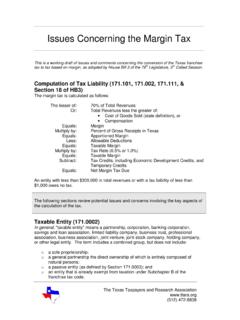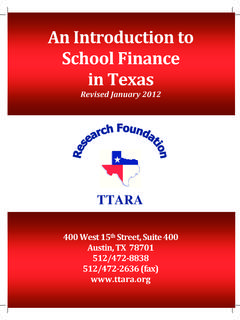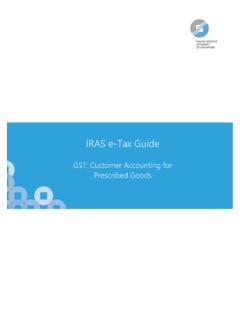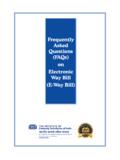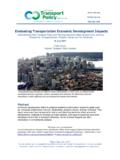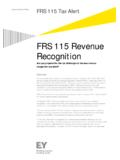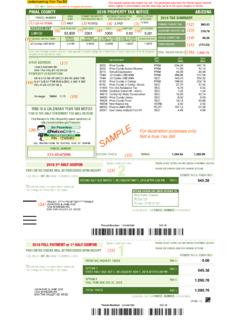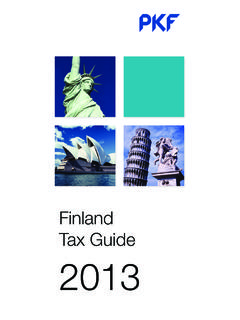Transcription of October 2011 Understanding the Texas Franchise …
1 October 2011 400 West 15th Street, Suite 400, Austin, TX 78701 * Phone 512-472-8838 * Fax 512-472-2636 Understanding the Texas Franchise or Margin Tax In 2006, facing a possible shutdown of Texas schools, lawmakers enacted a sweeping overhaul of public school finance. School maintenance and operations taxes were reduced, but cigarette taxes were more than tripled and the state s Franchise tax was revamped in an effort to raise The state also contributed additional dollars from excess general revenues so that the overall reforms resulted in a net tax cut to the Texas economy.
2 Although property taxes soon returned to their upward trend, the package remains the largest tax cut in the state s history. But today looking back five years later, the most widely discussed element of the package is the conversion of the largely profits-based Franchise tax to one based on a construct referred to as taxable margin. The rewrite of the tax was intended to accomplish a number of policy goals: Align the tax with a modern economy, Create a simpler business tax, Eliminate tax planning opportunities, and Raise roughly $3 billion in new state revenue annually.
3 After several years of experience with the tax, it is instructive to evaluate how it scored on those items, as well as to examine some of the common policy complaints about the tax. 1 A more thorough review of the 2006 package, especially the property tax changes, may be found in the TTARA Research Foundation s August 2008 study: Property Tax Relief: The $7 Billion Reality. Just What Is A Franchise Tax? While commonly referred to as the margin tax, the formal name of Texas business tax is still the Texas Franchise Tax a tax that Texas has levied in some form since the The tax is typically assessed in return for the privilege of doing business in a state, similar to a fee (in fact, the Bureau of the Census in its recap of state finances classifies Texas Franchise tax as a fee).
4 As a part of its privilege, the owners of the business receive liability protections under state law the business is a legal entity separate and apart from them. Throughout most of the 20th Century, the Franchise tax was calculated based on each corporation s net taxable capital total assets less debt. With the advent of modern accounting principles, the state s definition of debt came under fire in the courts resulting in huge amounts of tax refunds in the 1980s. In 1991, the tax was rewritten to apply to earned surplus essentially defined as corporate profits plus compensation paid to officers and directors.
5 The taxable capital calculation was retained, but for all intents and purposes was relegated to being an alternative minimum tax. 2 To limit confusion, in this publication the term margin tax will be used to describe the revised Franchise tax. Understanding the Franchise or Margin Tax Page 2 400 West 15th Street, Suite 400, Austin, TX 78701 * Phone 512-472-8838 * Fax 512-472-2636 The 2006 reforms radically restructured the tax once more (Figure 1), with an eye to raising roughly $3 billion of new tax revenue annually.
6 Previously applying only to corporations and limited liability companies (LLC),3 the tax was extended to partnerships and professional associations4 generally businesses that must formally register with the state and are afforded 3 The LLC was authorized as a form of business in Texas in 1991. In most states and under federal tax law, LLCs may elect whether to be taxed as an entity, or be a pass-through entity in which the owners pay tax on their earnings from the LLC. 4 General partnerships that are owned solely by natural persons and not other businesses are exempt, as are passive entities.
7 Certain liability protections under state law. The tax base was significantly expanded, as well. In effect, the tax became something of a hybrid between a tax on gross receipts and a tax on income, though not quite either one. Many of the deductions previously available to taxpayers were stricken, as were tax credits for research and development, jobs creation, and new capital investment. Further, affiliated companies were no longer required to file separate tax returns; instead, they combine their finances into a single return for the entire group.
8 Taxpayers now start with their total revenue, less some, but not all, types of flow-through income. Figure 1 Differences between the Old and the New Franchise Tax Item Pre-2008 Post-2008 Who Pays Corporations (C and S alike) Limited Liability Companies Corporations (C and S alike) Limited Liability Companies Partnerships (except general partnerships owned by natural persons) Business Trusts Professional Associations Tax Base Earned Surplus: Profits, plus large corporations must add officer/director compensation Capital: Assets less debt Total Revenue less the greater of: Cost of Goods Sold Compensation 30% of Total Revenues Apportionment Sales within Texas /Total Sales Sales within Texas /Total Sales Tax Rate Earned Surplus: % Taxable Capital: % Wholesalers/Retailers: % All Others: % Key Tax Credits Research and Development New Investment Jobs Creation None Method of Filing Separate entity: each separately organized entity, including subsidiaries, files a unique tax return Combined group.
9 A business combines the financial data for its unitary subsidiaries and affiliates into a single tax return Small Business Exemption Businesses with less than $150,000 in receipts exempt Originally businesses with less than $434,782a in receipts were exempted; now set at $1 million. Companies owing less than $1,000 are exempt. Businesses with less than $10,000 in total revenues may opt for a simplified EZ calculation based on gross receipts. Annual Revenue $ to $ billion $ to $ billion Notes: a While technically the small business exemption was $300,000, because of the $1,000 tax due threshold and a sliding scale discount for taxpayers with less than $900,000 in revenues, business with receipts less than $434, paid no tax.
10 Understanding the Franchise or Margin Tax Page 3 400 West 15th Street, Suite 400, Austin, TX 78701 * Phone 512-472-8838 * Fax 512-472-2636 From this, taxpayers subtract the highest of one of three items: Cost of goods sold: this includes items such as raw materials and production labor, among other items. While a commonly used federal tax term, Texas has adopted a different definition for margin tax purposes. For a company to claim this deduction it must sell goods; service companies are not eligible, Compensation: the amount a company pays in salaries (capped at $300,000 per employee, but adjusted for inflation) plus certain benefits, or 30% of total revenues: this option was included for those businesses that have little in the way of compensation or cost of goods sold (typically capital intensive services businesses, such as those in transportation or telecommunications).

